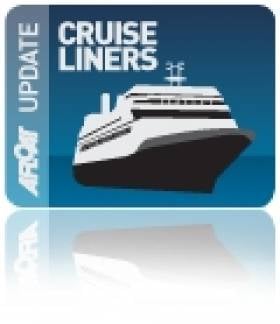Displaying items by tag: Irish Rail
A First for Cobh as Two Cruise Giants Come and Go
In an unprecedented scheduling of cruiseships to the Port of Cork (Cobh), the inbound Independence of the Seas (154,407 tonnes) the largest cruiseship to call to any Irish port, passed the 122,000 tonnes Celebrity Eclipse which was preparing to depart from the town's cruise terminal.
Some 15 minutes later Celebrity Eclipse pulled away from the berth. During that timeframe the Independence of the Seas had completely turned around in the opposite direction to face Cobh after maneuvering in the swinging basin between Cobh and the Naval Base on Haulbowline Island.
The 4,175-passenger Independence of the Seas is the third of the 'Freedom' class vessels. She has a length of 339m and is a mere 11m shorter in distance to that of the 350m berth at Cobh. The 38m wide cruiseship has a draft of 8.7m and the depth of water at the town's quayside is 9.1m.
The 15-deck vessel was built by Aker Finnyards in Turku, Finland in 2008 for Royal Caribbean International (RCI). Amenities on the Freedom class consist of the an innovative surf park, canitilevered whirlpools, ice-skating rink, full-size boxing ring and a H2O Zone waterpark.
As for the 3,179-passenger Celebrity Eclipse, she is the second of five 'Solstice' class sisters and measures 317m (length) 48m (beam) and draws 8.6m. On the top deck there is the fresh green grass located at Lawn Club. She was built by the Meyer Werft shipyard in Papenburg, Germany and entered service last year for her owners Celebrity Cruises.
Independence of the Seas departed yesterday afternoon on an overnight passage from Southampton where the vessel is based in the summer and for the winter she is based out of Florida. The Celebrity Eclipse departed the UK south coast port from Cobh where the larger cruiseship is also to make overnight port of call.
In total 10,000 passengers and crew will of visited the Cork Harbour region alone over the May Bank holiday. To meet the surge in demand for the shore-based excusions a fleet of buses awaited and additional trains were also laid-on by Irish Rail. The railway station is located next-door to the Cobh Heritage Centre which retraces the town's strong trans-Atlantic liner era.
- Cobh
- Cork Harbour
- port of Cork
- Independence of the Seas
- Ports and Shipping
- Cobh Cruise Terminal
- Ports and Shipping News
- Cork Harbour News
- Irish Rail
- Celebrity Eclipse
- Port of Cork News
- Aker Finnyards
- Celebrity Cruises
- Royal Caribbean International
- Freedomclass
- Solsticeclass
- MeyerWerft
- Cobh Heritage Centre
New Rail-Head Extension for Dublin Port
The Dublin Port Company has approved for the railway extension of the existing track tramway on Alexandra Road in order to serve one of the port's Lo-Lo container terminals, writes Jehan Ashmore.
The new extension is to directly connect rail-freight trains to the Common User Container Terminal at Alexandra Quay East. The extension will make a right turn off the Alexandra Road immediately after the Tara Mines zinc unloading facility and then along the quayside to the terminal, close to Ocean Pier.
Currently there are three weekly rail-freight trains running between Ballina, Co. Mayo and Dublin port, where the containers are required to be loaded and unloaded on Alexandra Road. From this location they are transferred by road to the terminal. When the new rail-tramway is completed in April, this will reduce costs by eliminating the transfer.
The rail-freight service to Dublin Port started operations in August 2009 and is run as a public private partnership between International Warehousing & Transport (IWT), Iarnrod Eireann and Dublin Port. IWT is the only train operator to the port, but it is believed that the Dublin Port Company has received a number of enquiries from other port users who are interested in using the new facility.
IWT are also agents for Tschudi Shipping and Tschudi Logistics on services to the Belgium, The Netherlands, Scandinavia and the Baltic Sea which use the Common User Container Terminal. The terminal is operated by the Burke Shipping Group through its subsidiary Portroe Stevedores. Other clients using the terminal are Cobelfret, C2C Lines, APL, Coastal Containers, Evergreen, Gracechurch and OOCL.
In addition to the terminal, the port operates two other container facilities at the Dublin Ferryport Terminal (DFT) and the Marine Terminals Ltd (MTL). According to figures released yesterday, Dublin Port recorded growth in Lo-Lo container volumes by 1.1% with an outturn of 554,259 TEU in 2010.
Dublin Port's position as the island's largest Lo-Lo (unitised) port was reinforced by the rail-freight services to Ballina. According to IWT the service on an annual basis saves up to 5.5m road kilometres and CO2 emissions are reduced by as much as 2,750 tonnes. In addition the service removes up to 10,000 trucks away from the roads.
The Common User Container Terminal is also a multi-model terminal, as Ro-Ro traffic started in 2009 with the installation of a new ramp at berth 36/37 at Ocean Pier, Alexandra Basin East. In 2010 the port recorded Ro-Ro freight units increase by 12.8% to 725,665 which is less than 1% down from the port's highest ever throughput.
Ro-Ro growth in 2010 was driven in part by the new CLdN /Cobelfret Ro-Ro services to Zeebrugge and Rotterdam. CLdN's ro-ro Yasmine made a recent first-time visit to the port followed by the newest vessel of the Belgium owned fleet, Amandine (see photo) the last of six con-ro newbuilds, which too made an inaugural visit to the port. The 195-m vessel departed from the upgraded ramp at Ocean Pier yesterday bound for Rotterdam.
For further port traffic figures which showed an overall increase in the port's volumes of 6.1% in 2010, logon here






























































